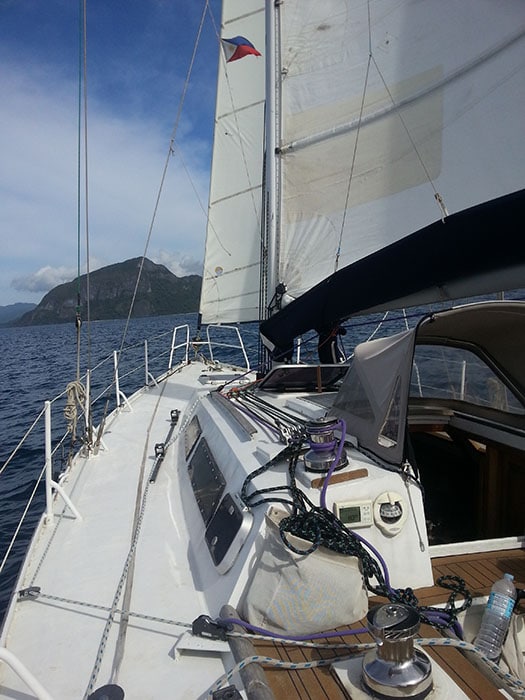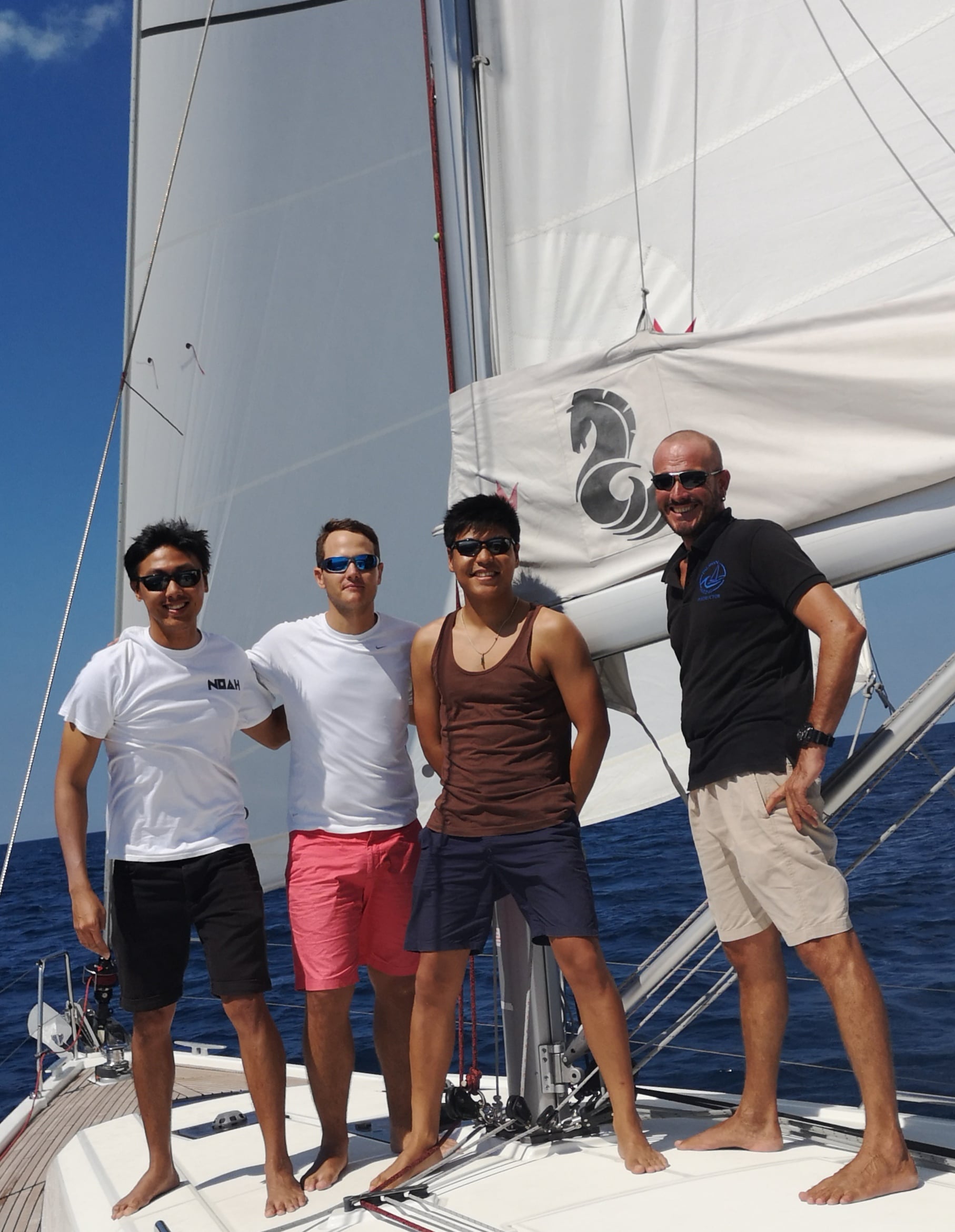The objective of Bareboat Skipper course is to prepare sailors to skipper a vessel on short passages by day.
Pre Course Experience: Watchleader or equivalent, 200NM and 10 days at sea
Assumed knowledge: A good command of sailing and crew handling
Duration: 5 days
Cost: €850
What I will learn?
- More compass and chartwork
- Even more Meteorology
- Passage planning
- Pilotage
- Rules of the road (IRPCS)
- Estimated Position – Running fix
- Man over board under Sail
- Engine maintenance
- Crew handling
- Marinas
- Instruments (GPS – Chart plotter – Radar – AIS – AutoPilot, etc…)
- VHF
What’s next?
With the Bareboat Skipper certificate you can charter a boat anywhere in the world for day trips. For those of you who want to explore the oceans a bit further, it is time to consider becoming a Offshore Yachtmaster.
More details about Bareboat Skipper course
The Bareboat Skipper Course is the final step to become a recognized skipper and be able to charter your own boat anywhere. This course introduces the experienced sailor to further in depth handling of a yacht. At the end of these 5 days course you will have become knowledgeable about a cruising yacht and the command of a crew.
This course is both theoretical and practical. In our comfortable classroom, we will deepen your knowledge of navigation, including further techniques for estimating your position with running fixes, taking into account leeway, passage planning, further understanding of tides and meteorology, rules of the sea (IRPCS), instruments such as radar and AIS, engine troubleshooting and maintenance.
During your practical session, you will be the skipper of our fully equipped 45 foot cruising yacht and your qualified instructor will devote plenty of time to supervise your command of the crew and vessel during emergency situations.
You will be asked to write a detailed navigation and piloting passage plan for a day trip, including calculating distances, bearings, tidal heights, tidal streams, safety anchorage. While sailing, you will keep an accurate log of the ship, plot your position using running fix and compare it with a GPS fix. You will be asked to navigate with the radar. During that trip someone will definitively fall off the boat just when your engine fails to start and you will supervise the Man Over Board rescue operation under sail only.
As a skipper, you can ask someone else to make you a cup of coffee.
More compass and chartwork
To the Compass Magnetic Variation learn in “International Flotilla Skipper” course, we will then add the Compass Deviation due to metal interference on the boat and build a Deviation Chart.
Even more Meteorology
What is a weather front ? What happens when a cold front meets a warm front ? How is a depression formed ? We will look at converging and diverging winds. By the end of this course you will know the difference between a Stratocumulus and a Nimbostatus cloud and what they mean for the weather.
Passage planning
If you plan a multi day trip, care should be taken to formulate a proper Passage Plan. Since the Titanic incident … this is the law even for leisure ships since 2005! Is your boat capable of the voyage ? Is your crew able ? Do you have all the maps, weather forecast, tide tables before you leave ? Will you take Aunt Martha ?
Rules of the road (IRPCS)
You know quite a bit about IRPCS already … but there is more. We will look at all the types of vessels and their various order of priority.
Estimated Position – Running fix
You will learn how to determine your position with a single point of reference and time. This complements our 2/3 point fix techniques.
Man over board under Sail
Aunt Martha has done it again and is now floating away when the engine won’t start. Too bad for Aunt Martha ? Nope. We will teach you how to retrieve a person over board under sail.
Engine maintenance
A good diesel engine will outlive you if you treat it well. We will go over the various maintenance aspects of a marine engine; from oil change to filter change, to impeller verification, testing the charge of the alternator, checking the batteries under load…
Crew handling
How do you tell your crew to put their life jacket, prepare for tacking, organize the mooring procedure, tell Uncle Bob to stop abusing the rum bottle in the morning ? Now you are the captain and in charge of communicating with your crew with a precise, assertive yet diplomatic language.
Marinas
Eventually we all have to go back to a marina. This is the dreadful moment when we enter an overcrowded space and have to squeeze our boat in between 2 large catamarans without scratching the hull. We will look at different approach techniques depending on the wind/tide directions. How do we safely secure the boat to the jetty ? What are spring lines ? Answers in this class.
Instruments (GPS – Chart plotter – Radar – AIS – AutoPilot,etc…)
Back in the days of Joshua Slocum, marine instruments meant just a compass. He did not even use a chronometer when he circumnavigated the world. Fast forward a hundred years and now most boats have as much electronics as a the latest Airbus. We will look extensively at the GPS of course but also the various instruments that help with navigation from wind meters to AIS, radar, autopilot … all except the Sextant which is in the celestial navigation class.
VHF
Having Aunt Martha on the boat and no more Gin Tonic may not be a valid reason to send a Mayday signal on the VHF but a fire or an unconscious person or a hole in the hull is pretty serious and outside help from the coastguards or nearby vessels will demand issuing an emergency message on channel 16. We will teach you VHF etiquette and how to properly formulate a “mayday” and “panpan” messages or what to do if you want to call uncle Bob on the VHF. This is a certified VHF course which is mandatory for obtaining your skipper license but won’t be required if you already have this certificate.
This course is taught on our 45 foot Levrier des Mers.

Book your course now :
Palawan Sailing courses start at 9:30am and finish at around 4:30pm.
We have a maximum of 4 students per boat and a minimum of 2 students. It is recommended that you contact us to book your course.
Call +639060185714 (please remember the time difference with the Philippines : UTC/GMT +8 hours) to inquire or book or use our contact form.
Bareboat Skipper Course Price
€850
You can pay by cash or Paypal. All our prices are fixed.
Our course package includes: boat rental and instructive materials, instructor’s fee, warm lunch made from fresh local ingredients. Our package does not include the Eco Tourism Development fee and has to be paid in cash. This ticket costs P200 and is valid for 10 days.
Note: All our courses have to be paid in Philipino Pesos. The prices in Euros are informative.

